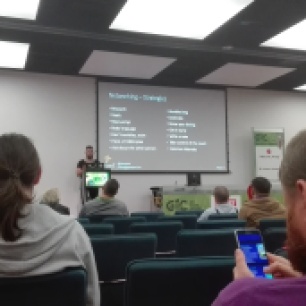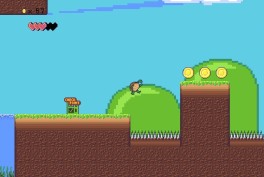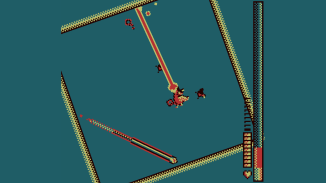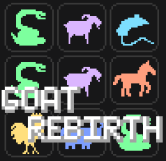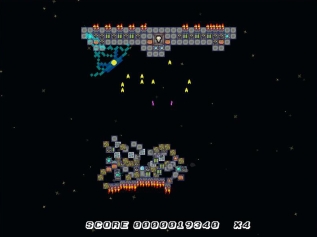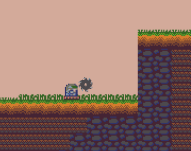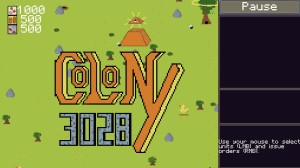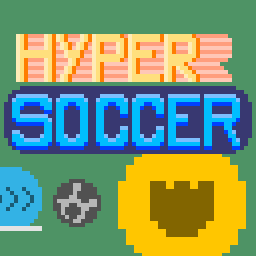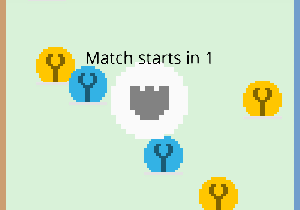After having gone over 2016 let’s dissect what happened in 2017. And what a year, I wrote way more than I anticipated, so grab something to eat, this’ gonna take a while.
Getting Kinda Serious
Somewhere around early 2017 I decided that Pixel Soldier could turn into something that I would feel proud of and want to expand on. But it’s always difficult to judge if what you do is actually good, or if you just think it’s good. So as to better judge where the game is at and further gauge interest, we polished the game a bit more, created a short teaser, and submitted the game to a few competitions. Incredibly Pixel Soldier managed to nominate for the SAGA (StyriAn Games Award), entailing a free exhibition spot at the Button Festival 2017.
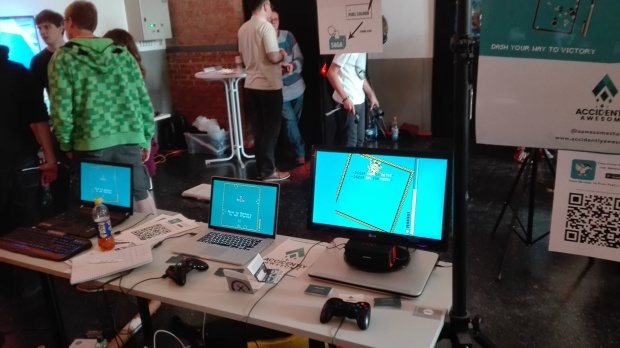
High profile exhibiting at Button Festival 2017 😉
I fancied the idea of exhibiting a game at an Event since attending Button Festival and Game Dev Days Graz in 2016. But never felt like what I had was good enough, but that thinking would stop with Pixel Soldier. Exhibiting at Button Festival 2017 was really cool. The feedback was overwhelmingly positive and constructive, the discussions with interested people invaluable and the observed possibilities for improvement numerous (meaning: a lot of bugs were found).
Getting to know the Environment
Meanwhile Florian, responsible for all the pleasing music in my games, and I decided that attending game development conferences would be a great way to get our feet wet in the industry, get a feel for the ins and outs and just in general meet people that are part of the game development community.
Therefore we drove all the way down to Dubrovnik to attend Reboot Develop 2017, as it has been recommended to us by others, who have been there the previous year. Long story short, it really was a great experience. We met and chatted with a ton of amazing people. Funnily, we also met people from Graz for the first time there. Apparently all it takes to meet people from the city you live in, is to drive 10 hours down to Croatia.

Lovely two hour detour through the mountains of Metkovic, Croatia. Thanks navigation system, next time let’s follow the road signs instead.
We didn’t exhibit there. We were just regular attendees, however the Android build on my phone allowed me to quickly show Pixel Soldier to people and get feedback on it. We absolutely think it was worth it. Tickets for this year are already bought 😉
Events are where the party is at
Exhilarated by the good time we had at Reboot Develop and Button Festival, our thirst for events couldn’t be quenched. Or at least we paid more attention to the massive amount of gaming related events that are actually all year around, especially within Austria. Attending events close by is obviously preferable, because it reduces travel costs immensely. So Florian and I (and sometimes I alone) went and exhibited Pixel Soldier at a lot more events over the year and attended a few more as regular attendees. I certainly found events to be exhausting, but also invaluable to get into contact with other game developers. (There is a breakdown of every single event further down.)
Quick list regarding exhibiting:
- It obviously makes a big difference whether you exhibit or attend regularly. Don’t expect to see too much of the event when exhibiting.
- Different events have different focus, anything from player, developer, press or business focus. This will strongly influence what audience there will be to see and play your game. Keep this in mind to help you determine the right event for exhibiting your game.
- Exhibiting with 2 people is to be preferred, but it’s certainly doable to exhibit alone. You will get to know your booth buddies really well, and they will usually have no problem keeping an eye on your booth while you grab something to eat.
- Take notes. You certainly won’t remember all ideas and bugs otherwise.
- Have a mailing list where people interested in your game can sign up for a release mail notification. A simple sheet of paper can be enough, if you didn’t prepare anything. Quickest and cheapest trick in the book. Speaking of which… There now is a mailing list, in case you don’t want to miss the release of Pixel Soldier.
- Whether you exhibit or not: Actually speak to people other than those you got there with. Has been difficult for me at first, but it starts to get easier for me.
- Attend the parties, if you can, that’s where the real deals are made (or so they say at least).
There is tons more of advice for exhibiting at events out there, which helped me a lot over the year. Can’t recommend anything specific, but it shouldn’t be too hard to find some talks on YouTube on the topic.
University and other Stuff
Besides all this I’m still studying Computer Science, where I did two student game projects, one of them together with students from Westminster University.
Tried out developing for AirConsole. It’s a pretty unique and neat concept, allowing anybody to join the game with their smart phone. However, I found that the delay can vary unpredictably which makes it less fit for faster paced games, in my opinion. Still, for creating local multi player games, it’s a great tool/framework.
Found out about Processing. It’s really quick and easy to get graphical demos or effects with it running. Might toy around with it in the future as a tool for prototyping visual effects.
Also doing some game jams here and there, because doing small condensed projects is great for varying up monotony of longer projects. Additionally it prevents the feeling of not getting anywhere.
2017 Timeline
In January I participated for the 2nd time in the Global Game Jam. Sadly I couldn’t be present the whole weekend. Nonetheless, I helped to create a game about blindly steering a boat while getting directions from another player.
In April we’ve been attending Reboot Develop in Dubrovnik. Beautiful location, although sadly not the right time of year for taking a swim in the ocean. Many high-quality talks, an indie expo area very central so that basically everyone will pass by it. And some of the people I only knew from the Internet, right there to talk to.
- (Personal highlights from the Indie Expo: Failure: NeuroSlicers, Blockships, Akuto: Mad World, End State, Hellmut: The Badass from Hell)

It looks so inviting for swimming, but don’t get fooled, it’s really cold.
In May we’ve been exhibiting Pixel Soldier at the Button Festival in Graz.
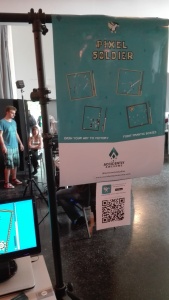
Button Festival 2017
Graz is of course a very convenient location for us. Great event all around, about anything gaming related. The exhibition spots for local developers being just a small part of it. Sadly, in the end we didn’t win the SAGA Award, but there is always a next time 😀
For all following events I kept track of the number of people that stopped and played Pixel Soldier, but for Button Festival I can only guess. So I guess about 50 to 60 people played over two days, could be way off though.
- (Shout out to great games I played at Button: A Hole New World, Goliath VR, Subwords)
In July I’ve been exhibiting at ReVersed Festival in Vienna. The Museumsquartier is a really lovely location. The games lineup has been more international, and I had great time meeting and chatting with developers from all over the world, even though I didn’t get to play all the games. Exhibiting for 4 days can be really exhausting, so I’m happy they decided that ReVersed 2018 will shorten it to 3 days instead, especially since the first two days, Thursday and Friday, have been rather slow and the main bulk of players coming in on Saturday and Sunday. It’s also interesting to see they are shifting more to a business and developer focus with The Big Indie Pitch and MeetToMatch. Looking forward to it.
In total there have been about 75 people playing the game.
- (Great games seen at ReVersed: Toast Time, Violet Cycle, Celaria, Splinter Zone, Kemono Heroes, Non Günz, Subwords again)
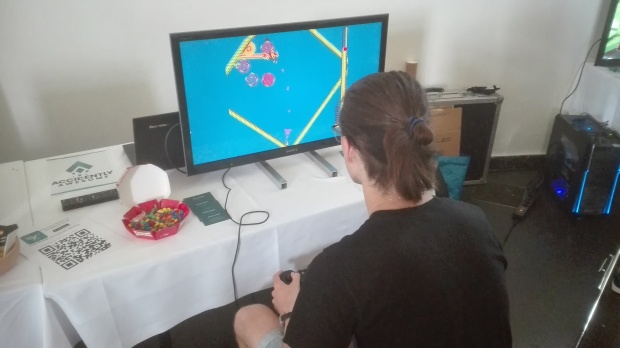
Force of Habit getting destroyed by the first boss at ReVersed Festival ;D
In August Ludum Dare 39 surprisingly fell on a less busy weekend. The theme was ‘Running out of Power’ and I managed to make a tiny, minimalist, experimental game about metaphors and squiggly physics. My idea for that jam was to pick one specific aspect or challenge that I can tackle and focus on. So the newfound knowledge can be reused for future projects. For this jam I tackled the problem of in-game recording of GIFs (Details of that will be the content of another post, I did not forget). Also the game did actually pretty good, ranking 13th in Innovation, so the concept seems to be unique, but is it any good?
In early September we’ve been exhibiting at Game Dev Days Graz in (you guessed it) Graz. Really great event with awesome speakers and great atmosphere. Bums me out that I missed most of them, because I was exhibiting (I wish all of them were online. *wink*). The wine tasting tour on Sunday made totally up for it though 😉
About 30 people played on a single exhibition day. That’s pretty good actually.
- (Shout out to the simply clever: POMG)
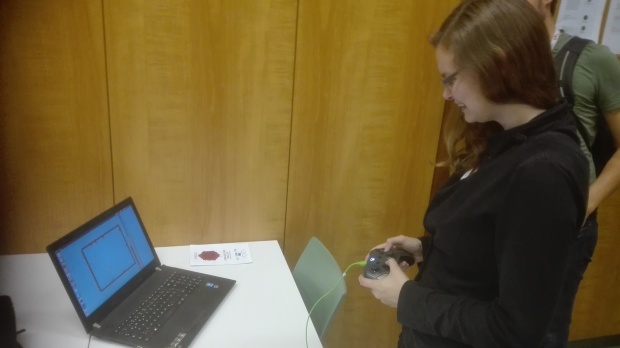
Philomena Schwab checking out Pixel Soldier
Later in September I’ve been exhibiting at Play Austria in Vienna.

Play Austria 2017
Really well visited event with tons of great games. Hardly even got to see half of it. The far end of the hall was noticeably less crowded than the entrance area, but that made it a more comfortable talking space. Overall I’m really impressed by the Game Development Scene in Austria.
Pixel Soldier got played by about 70 people.
- (Personal highlights: Weaving Tides, PEW, Scapeland, whatever that game using 16 Move Controllers was, also one student game I can’t find online anymore which makes me sad, also Subwords stop following me around! (just kidding))

Best usage for Move Controllers to date
Last day of September we’ve been attending Slovenian Games Conference in Ljubljana. Nice small event, with inspiring talks and various Indie games. Although it had two tracks for talks, it felt a bit smaller in scale than Game Dev Days Graz.
- (Looking promising: Last Encounter, Floatlands)

Oscar Clark’s “9 Ridiculous Questions Every #Gamedev should ask” at SGC. Thought provoking for sure, but we don’t have to agree on all of those.
In October I’ve been to the Game Industry Conference in Poznan. This event is coupled with Poznan Game Arena, “Poland’s biggest and most important computer games and entertainment fair”. So this was basically the largest event I’ve been to that year, making up for the fact that I couldn’t get to GamesCom. Met many awesome people, played a bunch of games and listened to a lot of great talks.
- (Had tons of fun with: Ruiner, Hamsterdam)
In early November, Jonathan Blow did a Q&A in Graz. If you missed that, I highly recommend watching the recording.
In mid November we’ve been exhibiting Pixel Soldier for the last time in 2017 at Game Developer Session in Prague. Another beautiful location, with awesome Indie Games exhibited on multiple floors. It provides a really personal atmosphere, great for chatting with people. My only regret was, that I still had to finish a submission for university, which took a few hours away on Friday evening. Remember to do your homework, kids!
About 50 people played the game there.
- (Worth getting a VR headset for: Beat Saber)

They come for the cookies, but they stay for the game. 😛
At around the same time in November @JaegerLo and I created Bixtris, a game for the Kunsthaus Graz hosting the Ludovico Festival der Spiele. It was played on the BIX façade of the Kunsthaus and controllable via Smartphone. Incredible feeling seeing your own work being visible on the outer wall of a public building (without resorting to vandalism), even when it was only playable for a week. In essence it played like 2 player competitive Tetris and I presented a small post-mortem about it.
In December I participated in Analog Game Jam, which was again a lot of fun. I wouldn’t want to miss it. I was part of a team that created a board game about one-way streets and road works using a city plan as the game board.
Summary
Pretty crazy year all around, I’m looking forward to an even crazier year. Exhibiting at events is time-consuming, but can be worth it. Certainly a balance has to be struck between talking about your game and actually developing said game. It isn’t feasible to attend all the events, but exhibiting at a few events, especially within Austria, is probably a sensible investment for us.
These retrospectives would be easier to write, if I had already written blog posts I could link to. Well, lesson learned.
If you bothered to read through all of this, thank you a lot for caring. If you care about Pixel Soldier too, don’t forget to sign up to the Mailing List.
Thanks for reading and see you at an event.
-Anton


